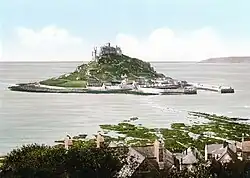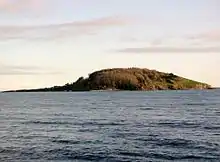Ictis
Ictis, or Iktin, is or was an island described as a tin trading centre in the Bibliotheca historica of the Sicilian-Greek historian Diodorus Siculus, writing in the first century BC.

to be Ictis
While Ictis is widely accepted to have been an island somewhere off the southern coast of what is now England, scholars continue to debate its precise location. Candidates include St Michael's Mount and Looe Island off the coast of Cornwall, the Mount Batten peninsula in Devon, and the Isle of Wight further to the east.
Primary sources
Diodorus Siculus, who flourished between about 60 and about 30 BC, is supposed to have relied for his account of the geography of Britain on a lost work of Pytheas, a Greek geographer from Massalia who made a voyage around the coast of Britain near the end of the fourth century BC, searching for the source of amber. The record of the voyage of Pytheas was lost in antiquity but was known to some later writers, including Timaeus, Posidonius, and Pliny the Elder. Their work is contradictory, but from it deductions can be made about what was reported by Pytheas. This “represents all that was known about the tin trade in the ancient classical world”.[1]
Diodorus gives an account that is generally supposed to be a description of the working of Cornish tin at about the time of the voyage of Pytheas. He says:
The inhabitants of that part of Britain which is called Belerion are very fond of strangers and from their intercourse with foreign merchants are civilized in their manner of life. They prepare the tin, working very carefully the earth in which it is produced. The ground is rocky but it contains earthy veins, the produce of which is ground down, smelted and purified. They beat the metal into masses shaped like knuckle-bones and carry it off to a certain island off Britain called Iktis. During the ebb of the tide the intervening space is left dry and they carry over to the island the tin in abundance in their wagons ... Here then the merchants buy the tin from the natives and carry it over to Gaul, and after travelling overland for about thirty days, they finally bring their loads on horses to the mouth of the Rhone.[1]
In the Greek text of Diodorus the name appears, in the accusative case, as "Iktin", so that translators have inferred that the nominative form of the name was "Iktis", rendering this into the medieval lingua franca of Latin (which only rarely used the letter 'k') as "Ictis". However, some commentators doubt that "Ictis" is correct and prefer "Iktin".[2]
In Book IV of his Natural History, Pliny quotes Timaeus and refers to "insulam Mictim" (the island of Mictis, or perhaps of Mictim):
There is an island named Mictis lying inwards six days' sail from Britain, where tin is found, and to which the Britons cross in boats of wickerwork covered with stitched hides.[3]
It has been suggested that "insulam Mictim" was a copying error for insulam Ictim, and Diodorus and Pliny probably both relied on the same primary source. However, while it is possible that "Mictim" and "Iktin" are one and the same, it is also possible that they are different places. The word "inwards" (introrsus) can be interpreted as meaning "towards our home", and six days' sail from Britain could take a boat to somewhere on the Atlantic coast of what is now France.[4]
Strabo, a contemporary of Diodorus, stated in his Geography that British tin was shipped from Massalia on the Mediterranean coast of Gaul.[5]
Julius Caesar, in his De Bello Gallico, says of the Veneti: "This last-named people were by far the most powerful on the coast of Armorica: they had a large fleet plying between their own ports and Britain; they knew more about the handling of ships and the science of navigation than anyone else thereabouts."[6]
Debate

William Camden, the Elizabethan historian, took the view that the name "Ictis" was so similar to "Vectis", the Latin name for the Isle of Wight, that the two were probably the same island. The Cornish antiquary William Borlase (1696–1772) suggested that Ictis must have been near the coast of Cornwall and could have been a general name for a peninsula there.[7]
In 1960, Gavin de Beer concluded that the most likely location of Iktin (the form of the name he preferred) was St Michael's Mount, a tidal island near the town of Marazion in Cornwall. Apart from the effect of the tide being consistent with what is said by Diodorus, de Beer considered the other benefits of St Michael's Mount for the Britons.[2] This identification is supported by the Roman Britain website.[1]
In 1972, I. S. Maxwell weighed up the competing claims of no fewer than twelve possible sites.[8] In 1983, after excavations, the archaeologist Barry W. Cunliffe proposed the Mount Batten peninsula near Plymouth as the site of Ictis.[3] Near the mouth of the River Erme, not far away, a shipwreck site has produced ingots of ancient tin, which indicates a trade along the coast, although dating the site is difficult and it may not belong to the Bronze Age.[9]
The assessment of Miranda Aldhouse-Green in The Celtic World (1996) was that
The two places considered most likely to be Ictis are the island of St Michael's Mount, Cornwall, and the peninsula of Mount Batten in Plymouth Sound (Cunliffe 1983; Hawkes 1984) ... Mount Batten seems archaeologically more likely as there are a number of finds from there which indicate it was prominent in international trade from the fourth century BC until the first century AD (Cunliffe 1988).[10]
Notes
- ICTIS INSVLA at roman-britain.co.uk
- Gavin de Beer, "Iktin", in The Geographical Journal vol. 126 (June 1960) pp. 160–167, at p. 162
- Barry W. Cunliffe, "Ictis: Is it here?" in Oxford Journal of Archaeology, vol. 2, issue 1 (March 1983), pp. 123–126 (see abstract)
- Barry Cunliffe, "Exchanges with the wider world" in Iron age communities in Britain: an account of England, Scotland, and Wales from the seventh century BC until the Roman conquest (Routledge, 1978) p. 471
- Strabo's Geographica, Book III, 2.9
- Gaius Julius Caesar, Caesar's War Commentaries (Kessinger, 2004), pp. 45–46
- Sir Christopher Hawkins, Observations on the tin trade of the ancients in Cornwall (1811), p. 63: "Mr. Camden supposes, that, from the similarity of the words Ictis and Vectis, it was one and the same island. Dr. Borlase says, that the Ictis must have been situated somewhere near the Coast of Cornwall, and have been a general name for a peninsula, or some particular peninsula, and common emporium, on the same coast."
- I. S. Maxwell, "The location of Ictis" in Journal of the Royal Institution of Cornwall 6 (4), pp. 293–319
- Erme Ingot Wreck Site Summary (English Heritage, 2000)
- Miranda Jane Aldhouse-Green, The Celtic World (1996), p. 276
Further reading
- Gavin de Beer, 'Iktin', in The Geographical Journal vol. 126 (June 1960)
- I. S. Maxwell, 'The location of Ictis' in Journal of the Royal Institution of Cornwall 6 (4) (1972)
- Barry W. Cunliffe, 'Ictis: Is it here?' in Oxford Journal of Archaeology, vol. 2, issue 1 (March 1983)
- John Taylor, Albion: the earliest history" (Dublin, 2016)
- S. Mitchell, Cornish tin, Julius Caesar, and the invasion of Britain (1983)
- Christopher F. C. Hawkes, 'Ictis disentangled and the British tin trade' in Oxford Journal of Archaeology, 3 (1984), pp. 211–233
- R. D. Penhallurick, Tin in Antiquity (London, 1986)